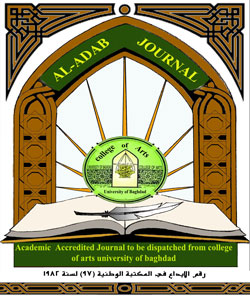ثنائية (اليوتوبيا – الديستوبيا) في الرواية العراقية دراسة سيميائية
DOI:
https://doi.org/10.31973/aj.v0i112.1449Keywords:
/Abstract
This study aims to bring to light the contrary binary (Utopia- Dystopia), which played a thematic role in three Iraqi novels, published after 2003: (Few Air) for the novelist Jinan Jasim Hillawy, (Star of AL- Battaween) for the writer Shakir AL- Anbari And (The Pomegranate Alone) for the writer Sinan Antoon. We will focus on the Semantic structure, by using the technique of Semiotic Square, which introduced by Paris School Semiotics, especially her pioneer Greimas.
This Study try to answer this question: Were Iraqi cities represent a utopian cities before 9 April 2003, and then became a dystopian cities after invasion of Iraq?
It is worth mentioning, the focusing on the theme of Dystopia in Iraqi and Arabic novels, has been overlooked from many modern narrative studies.
Downloads
References
2- أحمد عبد الرزاق، سجالية القوة والضعف، روايات عبده خال دراسة سيميائية، جامعة الملك سعود، كرسي الأدب، السعودية، ط1، 2015.
3- جنان جاسم حلاوي، هواء قليل، رواية، دار الآداب، بيروت، ط1، 2009.
4- جميل صليبا، المعجم الفلسفي، دار الكتاب الكتاب اللبناني، بيروت، 1982.
5- جون ليتشه، خمسون مفكرا أساسيا معاصرا، من البنيوية إلى ما بعد البنيوية، تر: فاتن البستاني، مركز دراسات الوحدة العربية، المنظمة العربية للترجمة، بيروت، ط1، 2008.
6- رشيد بن مالك، مقدمة في السيمياء السردية، دار القصبة للنشر، الجزائر،(د-ط)، 2000.
7- سمير المرزوقي وجميل شاكر، مدخل إلى نظرية القصة القصيرة، مشروع النشر المشترك، دار الشؤون الثقافية، الدار التونسية للنشر، 1986.
8- سنان أنطون، وحدها شجرة الرمان، رواية، منشورات الجمل، 2013.
9- شاكر الأنباري، نجمة البتاوين، رواية، دار المدى للثقافة والنشر، ط1، 2010.
10- عبد الحميد بورايو، التحليل السيميائي للخطاب السردي ، نماذج تطبيقية، دار المغرب للنشر والتوزيع، (د- ط).
11- غريماس، في المعنى، دراسة سيميائية، تعريب: نجيب غزاوي، مطبعة الحداد، اللاذقية، (د-ط)، (د-ت).
12- محمد مفتاح، حول مبادئ سيميائية، مجلة علامات، العدد: 16، 2004.
13- معد فياض، المليشيات في العراق إلى.. أين؟، جريدة الشرق الأوسط، العدد: 10090، 14 يوليو، 2006.
المواقع الألكترونية
Downloads
Published
Issue
Section
License
Copyright and Licensing:
For all articles published in Al-Adab journal, copyright is retained by the authors. Articles are licensed under an open access Creative Commons CC BY 4.0 license, meaning that anyone may download and read the paper for free. In addition, the article may be reused and quoted provided that the original published version is cited. These conditions allow for maximum use and exposure of the work.
Reproducing Published Material from other Publishers: It is absolutely essential that authors obtain permission to reproduce any published material (figures, schemes, tables or any extract of a text) which does not fall into the public domain, or for which they do not hold the copyright. Permission should be requested by the authors from the copyrightholder (usually the Publisher, please refer to the imprint of the individual publications to identify the copyrightholder).
Permission is required for: Your own works published by other Publishers and for which you did not retain copyright.
Substantial extracts from anyones' works or a series of works.
Use of Tables, Graphs, Charts, Schemes and Artworks if they are unaltered or slightly modified.
Photographs for which you do not hold copyright.
Permission is not required for: Reconstruction of your own table with data already published elsewhere. Please notice that in this case you must cite the source of the data in the form of either "Data from..." or "Adapted from...".
Reasonably short quotes are considered fair use and therefore do not require permission.
Graphs, Charts, Schemes and Artworks that are completely redrawn by the authors and significantly changed beyond recognition do not require permission.
Obtaining Permission
In order to avoid unnecessary delays in the publication process, you should start obtaining permissions as early as possible. If in any doubt about the copyright, apply for permission. Al-Adab Journal cannot publish material from other publications without permission.
The copyright holder may give you instructions on the form of acknowledgement to be followed; otherwise follow the style: "Reproduced with permission from [author], [book/journal title]; published by [publisher], [year].' at the end of the caption of the Table, Figure or Scheme.












